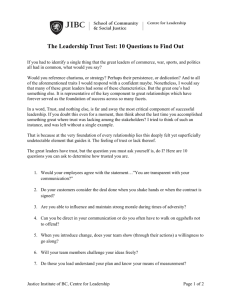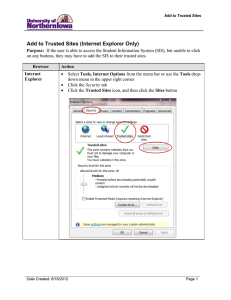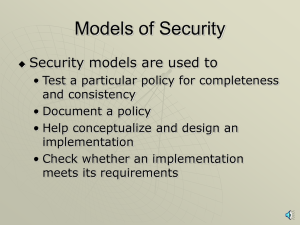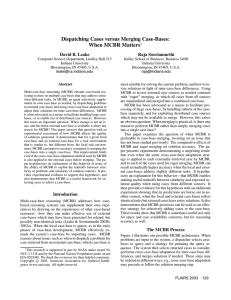Research Journal of Applied Sciences, Engineering and Technology 4(6): 587-590,... ISSN: 2040-7467 © Maxwell Scientific Organization, 2012
advertisement
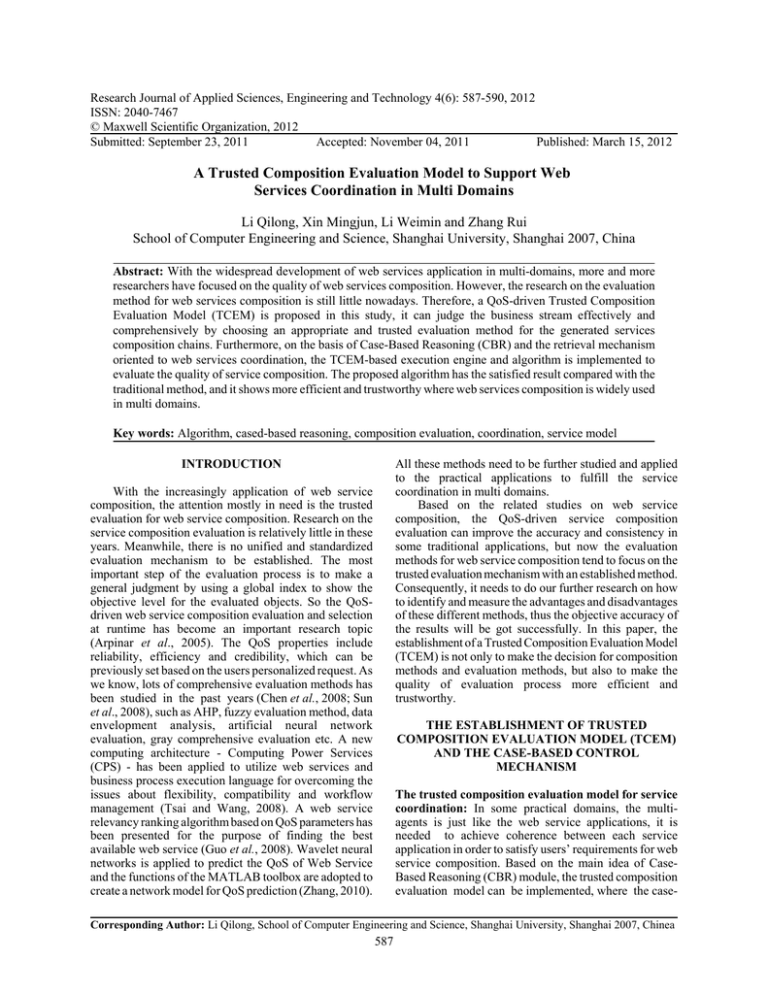
Research Journal of Applied Sciences, Engineering and Technology 4(6): 587-590, 2012
ISSN: 2040-7467
© Maxwell Scientific Organization, 2012
Submitted: September 23, 2011
Accepted: November 04, 2011
Published: March 15, 2012
A Trusted Composition Evaluation Model to Support Web
Services Coordination in Multi Domains
Li Qilong, Xin Mingjun, Li Weimin and Zhang Rui
School of Computer Engineering and Science, Shanghai University, Shanghai 2007, China
Abstract: With the widespread development of web services application in multi-domains, more and more
researchers have focused on the quality of web services composition. However, the research on the evaluation
method for web services composition is still little nowadays. Therefore, a QoS-driven Trusted Composition
Evaluation Model (TCEM) is proposed in this study, it can judge the business stream effectively and
comprehensively by choosing an appropriate and trusted evaluation method for the generated services
composition chains. Furthermore, on the basis of Case-Based Reasoning (CBR) and the retrieval mechanism
oriented to web services coordination, the TCEM-based execution engine and algorithm is implemented to
evaluate the quality of service composition. The proposed algorithm has the satisfied result compared with the
traditional method, and it shows more efficient and trustworthy where web services composition is widely used
in multi domains.
Key words: Algorithm, cased-based reasoning, composition evaluation, coordination, service model
All these methods need to be further studied and applied
to the practical applications to fulfill the service
coordination in multi domains.
Based on the related studies on web service
composition, the QoS-driven service composition
evaluation can improve the accuracy and consistency in
some traditional applications, but now the evaluation
methods for web service composition tend to focus on the
trusted evaluation mechanism with an established method.
Consequently, it needs to do our further research on how
to identify and measure the advantages and disadvantages
of these different methods, thus the objective accuracy of
the results will be got successfully. In this paper, the
establishment of a Trusted Composition Evaluation Model
(TCEM) is not only to make the decision for composition
methods and evaluation methods, but also to make the
quality of evaluation process more efficient and
trustworthy.
INTRODUCTION
With the increasingly application of web service
composition, the attention mostly in need is the trusted
evaluation for web service composition. Research on the
service composition evaluation is relatively little in these
years. Meanwhile, there is no unified and standardized
evaluation mechanism to be established. The most
important step of the evaluation process is to make a
general judgment by using a global index to show the
objective level for the evaluated objects. So the QoSdriven web service composition evaluation and selection
at runtime has become an important research topic
(Arpinar et al., 2005). The QoS properties include
reliability, efficiency and credibility, which can be
previously set based on the users personalized request. As
we know, lots of comprehensive evaluation methods has
been studied in the past years (Chen et al., 2008; Sun
et al., 2008), such as AHP, fuzzy evaluation method, data
envelopment analysis, artificial neural network
evaluation, gray comprehensive evaluation etc. A new
computing architecture - Computing Power Services
(CPS) - has been applied to utilize web services and
business process execution language for overcoming the
issues about flexibility, compatibility and workflow
management (Tsai and Wang, 2008). A web service
relevancy ranking algorithm based on QoS parameters has
been presented for the purpose of finding the best
available web service (Guo et al., 2008). Wavelet neural
networks is applied to predict the QoS of Web Service
and the functions of the MATLAB toolbox are adopted to
create a network model for QoS prediction (Zhang, 2010).
THE ESTABLISHMENT OF TRUSTED
COMPOSITION EVALUATION MODEL (TCEM)
AND THE CASE-BASED CONTROL
MECHANISM
The trusted composition evaluation model for service
coordination: In some practical domains, the multiagents is just like the web service applications, it is
needed to achieve coherence between each service
application in order to satisfy users’ requirements for web
service composition. Based on the main idea of CaseBased Reasoning (CBR) module, the trusted composition
evaluation model can be implemented, where the case-
Corresponding Author: Li Qilong, School of Computer Engineering and Science, Shanghai University, Shanghai 2007, Chinea
587
Res. J. Appl. Sci. Eng. Technol., 4(6): 587-590, 2012
Fig. 1: The structure of the trusted composition evaluation model
Accordingto the definition and thecorresponding weight
been set for service composition evaluation, the
appropriate Case-Based Reasoninglibrary (CBRL) can be
got.
For example,when aweb service compositionto
beevaluated, T (Petrinets),can beselected and evaluatedto
determinethe appropriatesolutionS (AHP). And
eachcasehas itsown ID, such as A-1. It is just the
sameforT (graph-basedplanning) that can beselected and
evaluatedto determinethe SolutionS (ANN),and thecaseID
is defined as A-8. Using the discussed structure, if there
is suitable case for service composition in CBRL, the
CBR process can then reuse the case.
base for service composition evaluation is created for the
matching process. The basic TCEM structure is shown in
Fig. 1. The working mechanism ofthis modelcan be
summarized asfollows:
C
C
C
C
C
Discovering the problem and the conversion of date.
The proposed problem by users is primarily treated
that undergoes the basic processing of the original
problem..
Setting the global index. The date contains the
integration andprocessing of the evaluation library in
order to set theindex as indicators.
Selecting the appropriate service composition
method. The appropriate and satisfied method is
determined, thus the various services will be
coordinated in multi domains.
Searching the case-base of web service composition
method. The results ofa successfulmatch may be
returned, otherwise, thecase-base will be modified
Evaluating the final solution. On the basis of the
selected composition method, the corresponding
evaluation methods will be selected to evaluate the
returned solution.
THE IMPLEMENTATION OF THE EXECUTION
ENGINE AND THETCEM-BASED ALGORITHM
The basicexecution process ofcomposition evaluation
execution engine: As shown in Fig. 1, the execution
engine contains three main parts, which are named as
input part, processing part and output part separately.
Each of the parts has its own working mechanism in the
execution control process. According to the TCEM
discussed above, the input part undertakes the monitor of
control for requirement description, translator, original
problem description and global index setting etc. The
processing part does the control task for service
composition selection module, coordination module and
evaluation selection module. Then, the output part does
the control work for the final date output. The process of
the execution engine is listed as follows:
The retrieval of the case-base for service composition
evaluation: The case-base to support the aboveTCEM
structurecan be divided into 2 categories, which named
case-based reasoningmodule and expertanalysis module
separately. Based on theprinciple of TCEM,there are
some definitions listed as follows. Definition [*] triple {S,
T, ID}, S represents the evaluation solutions, T represents
composition methods to be evaluated, ID represents each
case serial number. In the same case-base for web service
composition, the serial number of each case is unique.
C
588
The execution engine calls web service parser to
analysis the business process definition files, and
Percentage of correct choice
Res. J. Appl. Sci. Eng. Technol., 4(6): 587-590, 2012
C
Model selection
Manual selection
C
100%
90%
80%
C
70%
C
60%
50
100
150
250
200
Frequency of the test
Fig. 2: The experimental result of TCEM-based algorithm
C
C
produces the corresponding process instance objects
At run-time, web services will be called back and
transmit the activity execution parameters, checking
the result after termination conditions. If the
execution process is completed, the TCEM manager
will output the intermediate results
It will check the condition according to the execution
environment, in order to judge whether the execution
process is achieved
B
The implementation of the TCEM-based algorithm:
The selection of the evaluation methods is based on
different choices of composition methods; That is to say,
each web service composition will be specified with the
corresponding evaluation indicators and parameters
before the evaluation process begins. In this process, these
following factors will become the basis of the selection
strategy for service evaluation methods, which includes
the number of evaluation factors, the extent of user
involvement and the complexity of the problem. Two
definitions for the evaluation methods are given as
follows:
Definition (Singh, 2003), For certain service
composition methods in multi domains, just to define aNtuple Q = <a1, a2, an>, an represents the characteristics of
the service composition method, an = 0, 1, 2, 3, 4, 5.
When the value increases, the higher degree membership
of this property will be expressed for this service
composition method.
Definition (Wan-Cheng et al., 2008), According to
the characteristics of the evaluation method, to define a
M-tuple S = <b1, b2, bm>, bm indicates the
characteristics of the evaluation method for service
composition, and bm takes discrete value, bm = 0, 1, 2, 3,
4, 5. The greater the returned value is, the better
performance of the evaluation method on the
characteristics.
The TCEM-based algorithm is designed as follows
Algorithm (Singh, 2003):
Requirement description ->Translator ->The original
problem.
Service matching in the service library
For (I = 1, i#[library] , i++){Select the suitable
service in the library. Give each selected service a
lab}
Call for Agents->The retrieval of the composition
method library-> Coordination Engine.
The retrieval of the composition evaluation library
If there is the corresponding composition evaluation
case in the library . Reuse of the case
Else Algorithm (Wan-Cheng et al., 2008), the
proposed evaluation algorithm for service and
composition selecting. According to the experts, it is
necessary to set the number of the value and the
definition of the value for service composition
method.
For (I = 1, i#n, i++)
Step1,compareeach parameter in N-tuple: a1, a2, …
an, an with the corresponding one in M-tuple: b1, b2,
…, bm. (n = m).
Step 2, get the difference in value and set the
value as c.
Step 3, calculate the accumulation of the parameter
value:
1/ p
p
n
c = ⎡∑i=1( ai −bi ) ⎤
⎢⎣
⎥⎦
B
To make sort of each value:
1/ p
p
n
c = ⎡∑i=1( ai −bi ) ⎤
⎥⎦
⎣⎢
the smaller the value of:
1/ p
p
n
c = ⎡∑i=1( ai −bi ) ⎤
⎢⎣
⎥⎦
B
the higher the matching degree is.
For the generated composition evaluation methods to
be selected, according to the needs of users, to select
one with the smaller value of:
1/ p
p
n
c = ⎡∑i=1 ( ai − bi ) ⎤
⎢⎣
⎥⎦
B
589
as the result.
Assign the case with the ID value ID *,Create the
triple against the ID, S = (ID, Type, Scheme)
S. ID = I D*; S. Type = Type*; Scheme = Scheme*;
Add the case into the case base, and update the
operations of the case base.
Res. J. Appl. Sci. Eng. Technol., 4(6): 587-590, 2012
(Project Number. J50103), Great thanks to all of our hard
working fellows in the above projects.
The TCEM’S comparative test of the evaluation
method selection: In order to make the experimental test,
the model is applied to a travel planning application, the
multiple comparison tests are made in this case. In order
to get the more satisfied result of the experiment, different
times of the tests are executed, and the test results are
shown in Fig. 2.
REFERENCES
Arpinar, B., R. Zhang, B. Aleman-Meza and M. Angela,
2005. Ontology-driven web services composition
platform. Inf. Syst. E-Business Manage., 3(2):
175-199.
Chen, W., L. Xiong andL. Jiyao, 2008. The analysis of
cooperative strategies based on multi-agent system.
Chinese Control and Decision Conference, CCDC,
pp: 4511-4516.
Guo, L.I., H.P. Chen, G. Yang and R.Y. Fei, 2008. A
QOS Evaluation Algorithm for Web Service Ranking
Based on Artificial Neural Network. International
Conference on Computer Science and Software
Engineering, Wuhan, China, pp: 381-384.
Singh, M.P., 2003. Trustworthy service composition:
challenges and research questions. Lecture Notes in
Computer Sci. Springer-Verlag, 26(31): 39-52.
Sun Z, H. Jun and D. Dong, 2008. Five Perspectives on
Case Based Reasoning. 4th International Conference
on Intelligent Computing, ICIC, September 15,
2008-September 18, pp: 410-419.
Tsai, M.J. and C.S. Wang, 2008. A computing
coordination based fuzzy group decision-making
(CC-FGDM) for web service oriented architecture.
Expert Syst. Appl., 34(4): 2921-2936.
Wan-Cheng, N.I., L.I.U. Lian-Chen and W.U. Cheng,
2008. Survey on Web Services composition methods.
Comput. Eng., 34(4): 79-81.
Zhang, J.H., 2010. A Short-Term Prediction for QOS of
Web Service Based on Wavelet Neural Networks.
International Conference on Computational
Intelligence and Communication, Bhopal, India, pp:
254-258.
CONCLUSION
It firstly compares several popular evaluation
methods for web service composition in multi
applications, meanwhile the characteristics of service
coordination is also considered in this paper, Then, a
trusted composition evaluation model called TCEM is
proposed to promote the service quality in multi-domains.
Furthermore according to the QoS-based evaluation
method for service composition, the controlling module of
the above model is reliable and trustworthy in the method
of selection process. Finally, the TCEM-based algorithm
is designed by determining the composition method and
evaluation method. The algorithm is implemented just on
the basis of the definition of N-tuple and M-tuple of the
service composition and service evaluation method. On
comparing the operation of characteristics, the satisfied
result will be got in the travel planning application. It is
also helpful to promote the efficiency of evaluation
process for web service composition.
ACKNOWLEDGMENT
This study is supported by National Natural Science
Foundation of China (Project Number. 61074135 and
61003248), Shanghai Creative Foundation project of
Educational Development (Project Number. 09YZ14),
and Shanghai Leading Academic Discipline Project
590
